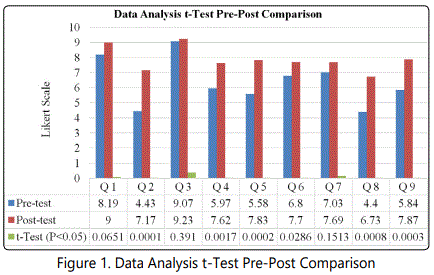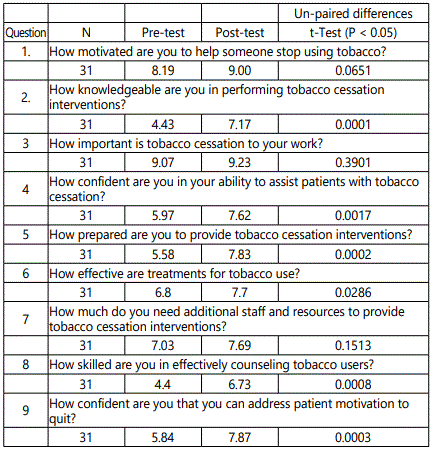Research Article
Tobacco Cessation Brief Intervention Training for Undergraduate Nursing Students
Assistant Professor, School of Nursing, College of Health and Human Services, USA
*Corresponding author: Jessica Grimm, Assistant Professor, School of Nursing, College of Health and Human Services, USA, Tel: (702) 777-3119, E-mail: Jessica.Grimm@tun.touro.edu
Received: December 12, 2018 Accepted: December 28, 2018 Published: January 3, 2019
Citation: Grimm J, Fildes E. Tobacco Cessation Brief Intervention Training for Undergraduate Nursing Students. Madridge J Case Rep Stud. 2019; 3(1): 108-111. doi: 10.18689/mjcrs-1000126
Copyright: © 2019 The Author(s). This work is licensed under a Creative Commons Attribution 4.0 International License, which permits unrestricted use, distribution, and reproduction in any medium, provided the original work is properly cited.
Abstract
The United States Preventive Task Force recommends tobacco cessation as a preventive service with a high certainty of substantial benefit. Brief intervention training for healthcare providers in treating tobacco use and dependence has been well established in the literature. Undergraduate nursing students' may be at an optimal time in their career to undergo training on appropriate tobacco cessation teaching methods. The purpose of this project was to assess the outcomes of tobacco brief intervention training for undergraduate nursing students. Outcomes include knowledge of tobacco use health and economic impact and use of brief intervention for tobacco use by undergraduate students. This study demonstrates that brief intervention training may reasonably be administered during traditional nursing school curriculum. Further studies are warranted to evaluate if this training has any impact on quality of patient instruction during patient interactions.
Keywords: Tobacco Cessation; Cigarettes; Nursing; Smoking Cessation.
Introduction
Tobacco use remains the single most preventable cause of death and disability in the United States [1]. Worldwide, cigarette smoking is responsible for nearly six million deaths a year [2,3]. In 2016, 16.5% of United States (US) adults smoked cigarettes and tobacco was responsible for approximately 400,000 deaths [2,3]. Nevada has the 9th highest smoking rate in the nation with 21.3% of adults currently smoking [1]. In Nevada, 18.7% of all deaths in adults 35 years or older can be attributed to cigarette smoke [1]. It is estimated that 68,600 people in Nevada are living with a smoking-attributable illness [1]. Tobacco use is associated with significant increases in healthcare costs. Approximately 1.1 billion dollars was spent in smoking related healthcare costs in 2009 [1]. Tobacco cessation is a highly effective measure to reduce the morbidity and mortality associated with tobacco use. Tobacco cessation reduces the burden of disease significantly and is cost-effective [4]. The risk of developing a tobacco related illness or dying from a tobacco related illness is significantly decreased by quitting smoking [5,6].
Smoking cessation teaching is a vital component of quitting smoking [7]. Nurses have been shown to be effective interventionists for smoking cessation teaching [7]. Given the large number of nurses in the United States, nurses can influence national health objectives of reduced tobacco use significantly and help decrease the number of adults at risk for tobacco-related diseases and death as well as second hand smoke exposure [7]. Nursing students are at an ideal time for learning and applying new skills. This study aims to examine the efficacy of including smoking cessation teaching as a standard component of nursing student's curriculum. Specifically, brief intervention training for smoking cessation will be delivered to nursing students to examine the effectiveness of this intervention.
Background
Previous research has shown that a primary barrier to implementing tobacco cessation education into nursing curricula is the limited amount of time available in the already inundated coursework [8]. Outcomes of recent research has shown that minimal instructional time is necessary to significantly increase knowledge, skills and abilities of nursing students to council their patients on smoking cessation. Butler conducted a quasi-experimental two cohort study to evaluate outcomes with varied length in educational intervention [9]. One group received 6 hour didactic component and additional hands on practice, the other group receiving a 2 hour didactic intervention. Using a tested pre and post-test survey this study found no difference between groups and a significant increase in skills, knowledge confidence and activity after completing intervention [9]. Another study provided baccalaureate nursing students with 2 hour didactic intervention and found a significant improvement in five areas of self-efficacy including advising patients to quit, helping patients set a quit data, helping patients with nicotine replacement therapy or medications and arranging follow-up [10].
Literature Review
Research results support the effectiveness of brief intervention training for healthcare providers in treating tobacco use and dependence [11]. Outcomes of improved knowledge, skills, and motivation towards smoking cessation provided by practicing nurses have beendocumented in the literature [12]. However, the outcomes and understanding of how undergraduate nursing students' learning and practice can be affected by similar educational interventions is not known.
The United States Preventive Task Force (USPTF) recommends tobacco cessation as a preventive service with a high certainty of substantial benefit. Tobacco use screening and assistance could contribute to more than $1 billion in net medical savings [13]. The role of the nurses and nursing students coupled with the enormous cost saving anticipated with tobacco cessation provide an opportunity for reducing the burden of tobacco use through tobacco brief intervention. When patients are counseled by nurses, they are twice as likely to attempt to quit smoking [14]. Registered Nurses (RNs) who attended smoking cessation training in evidence-based treatment of tobacco use and dependence reported significantly increased tobacco-related knowledge, motivation, confidence, perceived importance, perceived effectiveness, perceived importance of barriers and preparedness [15]. What is not known is if student nurses in undergraduate programs will report similar outcomes to smoking cessation training and foster similar patient results in clinical practice.
Recent advances in reduced smoking rates have been a product of four policy changes. Those policy changes are include increasing cigarette prices via taxation, comprehensive smoke-free policies, media/advertising to counter the protobacco industry, and increased access to affordable and effective treatment and services to smokers [11]. The strategies of particular importance to undergraduate nursing students are comprehensive smoke-free or tobacco-free environments, especially in healthcare systems and increasing affordable and effective treatment for smokers [13].
Design
A pre-post-test design was used. Participants were recruited from designated undergraduate nursing classes that have been selected to incorporate tobacco cessation efforts. The training will be part of the class and will be integrated into a Health Assessment Module. Tobacco cessation is part of nursing school curriculum, but research has found that very little if any time is dedicated to the topic [16].
The Study
The study took place at a small private medical university in the west. IRB approval was obtained by the university committee.
Training
The intervention will consist of a lecture educating students on how to perform a tobacco cessation brief intervention. Study activities include a Brief Intervention for Tobacco Use Power Point presentation. The presentation includes the following; 1. Information on the harmful effects of tobacco use, 2. Importance of tobacco cessation Brief intervention, 3. Samples of dialogue that can be used when engaging with patients and, 4. Call to action for future nurses to provide brief interventions.
Training is designed to be as brief as possible in order to be incorporated into the dense nursing curriculum. A thirty minute intervention was selected because the focus of the research is to find the least amount of time to make a significant change in measurable outcomes. There is very little time in the nursing curriculum to add information, and tobacco cessation content that is short, easy to use and effective will have the greatest impact.
Data Collection
With permission from Sarna, an established survey will be used to determine pre-intervention knowledge, skills and self-efficacy [8]. Prior research has tested the survey for validity and reliability and consent was obtained to use this tool. The same survey will be used post intervention and again at 6 months post intervention. Participants will be asked demographic criteria which will not be identifiable.
Ethical Considerations
Students had the option to not participate in the survey with no repercussion for not participating. Tobacco cessation intervention aligns with the nursing school curriculum and regardless of participation in the survey students will be presented the intervention information. A separate sheet of paper providing these details was presented to students. See attached “student disclaimer” document.
Data Analysis
Data analysis was done using statistical software on Excel. Unpaired pre-post tests were examined using a t-Test with a p value of <0.05.
Results
Demographics: Students were selected to participate based on enrollment is first year nursing course. A total of 31 participants completed a pre and post intervention survey. The average age of participates is 25.3 years with the youngest participant being 19 years old the oldest 45. Four participants did not provide their age. The majority of participants identified themselves as female (F=25), 81% and 16% identified as male (M=5). For participants who provided information, race and ethnicity is as follows; White = 16, Asian or Pacific Islander = 12, Hispanic = 3 Multi-ethnic = 1, and Black = 1. 13% self-identified as current smokers, 10% as former smoker and the 71% of never smoking. None of the participants had received any former formal tobacco cessation training.
A statistical difference was seen in six of the nine pre-posttest questions. The questions asking participants how motivated they are to help someone stop using tobacco did not show statistical significance (P = 0.0651). Additionally, the questions “How important is tobacco cessation to your work?” and “How much do you need additional staff resources to provide tobacco cessation interventions?” did not show a statistical difference with a P value = 0.3901 and 0.15.13 respectively.


Discussion
For this pre/posttest, a Likert scale (0-10) was utilized where 10 indicates the strongest agreement with the question and 0 indicates no agreement with the question. Out of nine questions administered, six questions showed a statistically significant improvement in the level of agreement when comparing pre-test answers to post-test answers. The question items that involved the nursing students' knowledge, confidence, feelings of preparedness, attitudes surrounding effectiveness of tobacco cessation treatments, and perception of skill level pertaining to tobacco cessation smoking showed significant improvement following the intervention. This demonstrates that brief teaching during nursing school curriculum can be effective in improving nursing student's knowledge, skills, and attitudes in relation to smoking cessation teaching. Further research is needed to examine if these effects carry into the clinical setting or make an impact on patient outcomes.
Three questions were considered statistically insignificant when examining pre-test answers against post-test answers. “How motivated are you to help someone stop using tobacco?”, “How important is tobacco cessation to your work?”, and “How much do you need additional staff and resources to provide smoking cessation interventions?” each showed insignificant results when comparing the pre-test to the post-test. Participants demonstrated high pre-test scores and maintained similar level of scoring on the post-test for each of these items and therefore it was difficult to achieve an improvement in these areas.
The study does show a significant increase in knowledge, confidence and skills necessary to successfully provide a patient with a tobacco cessation intervention. Coupled with high motivation, a significant increase in knowledge, confidence and skills, these nursing students may enter their professional nursing career well equipped to make a positive impact on patient outcomes related to smoking cessation.
The study design of the research did not have the capability to measure the effectiveness of the intervention in patient outcomes. This is an area of research that is ongoing and is critical to determine the long term effects of the intervention. Further studies are warranted on this topic.
References